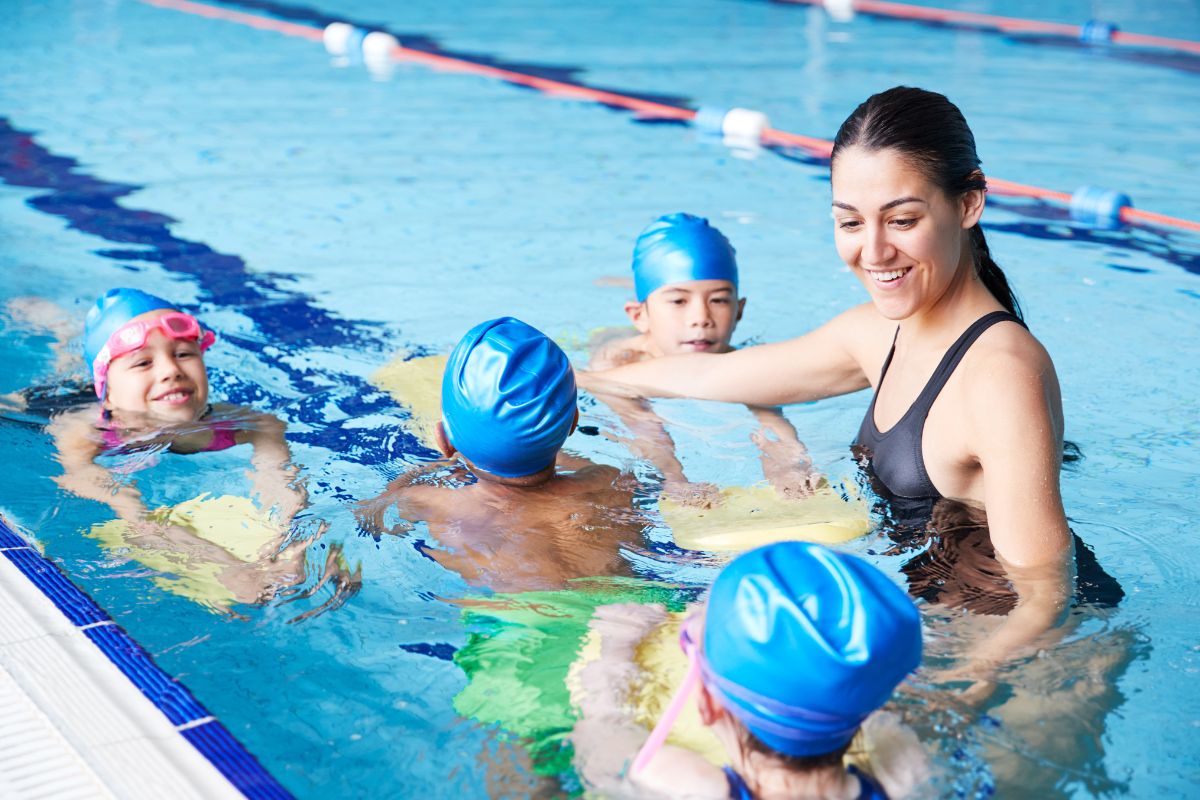How to Teach Kids Teamwork Through Sports

Team sports offer a fun way for children to learn cooperation, communication, and shared goals. Research shows that participating in team activities helps kids develop social skills and confidence. For example, one study found parents value sports for teaching “how to get along with others,” with 78% noting it improves teamwork and social life. Being part of a team gives children shared experiences of success and failure, teaching them to resolve conflicts and support one another on and off the field. Sports also build leadership and accountability – adolescents in team sports learn dedication and can take on leadership roles as well as follow others. In short, team sports help children practice life skills in a safe, game-like environment.
Benefits of Teamwork Through Sports
-
Improved Social Skills: Being on a team teaches cooperation, communication, and respect. Children working toward a common goal learn to share ideas and listen to peers, which builds camaraderie and social confidence.
-
Emotional Resilience: Team sports expose kids to winning and losing together. They learn to handle disappointment (e.g. a loss) and celebrate success as a group. This “succeed-or-fail in a safe environment” builds resilience and teaches healthy conflict resolution.
-
Leadership & Responsibility: Coaches can give children roles (team captain, position leader) so each player takes responsibility. Teens in sports often report learning accountability and leadership by working with teammates. When children commit to practices and games, they learn reliability – if “one person isn’t there … the team is not as strong,” reinforcing responsibility.
-
Confidence & Self-Esteem: Contributing to a team success (a good play or a win) boosts a child’s confidence. Mastering skills and supporting teammates provides positive reinforcement that raises self-esteem.
Overall, research finds that team sports support physical fitness along with social and emotional development. For example, a review notes that school-based team sports “promote discipline, teamwork, physical fitness, and social interaction” while enhancing communication and problem-solving skills. Parents and educators agree that beyond exercise, sports teach children how to cooperate and persevere.
Teamwork by Age Group
Early Childhood (Ages 3–5): Preschoolers learn best through play. Teamwork lessons at this age should focus on simple, fun games that encourage sharing and cooperation rather than competition. Short activities (5–15 minutes) with clear visuals and routines keep young children engaged. For example, parents or coaches can have toddlers take turns kicking a ball, or do partner relay races (e.g. rolling a ball back and forth) to emphasize teamwork. his stage, even everyday tasks (sharing toys or helping with household chores as a “team”) reinforce the same ideas.
Elementary School (Ages 6–10): As children get older, their physical and cognitive skills improve. Kids around 6–8 can handle basic team rules and small-sided games (e.g. 3-on-3 soccer or tee-ball). The focus should remain on fun and skill-building. Coaches can introduce basic strategy and team roles, like explaining what a “goalie” does in soccer or who covers bases in baseball, but should emphasize practice and personal improvement over winning. Children at this age begin to understand rules and feel pride in team identity. Practical ideas include:
-
Team Rituals: Have kids create a team cheer, mission statement, or handshake. This builds unity. For example, letting teammates pick a fun team name or cheer gives them ownership.
-
Inclusive Drills: Use mixed-ability teams or fun cooperatives (like all players must touch the ball before shooting) so everyone participates. Small-group drills (e.g. 3-on-3 scrimmages) force kids to communicate and rely on each other to score.
-
Clear Roles and Goals: Coaches should explain each player’s role and set group goals. Kids can vote on a team motto or sign a “team contract” to encourage commitment. Research notes that children benefit when they have clear roles and a group mission. For example, having a “passing award” or a goal for the team (e.g. make 10 good passes) helps everyone focus on teamwork.
Importantly, elementary-aged children should play multiple sports and activities. The readiness research advises “participation in activities that focus on cooperation and socialization allow preschool-aged children to practice, refine skills, and have fun”. In practical terms, a 6–10 year-old’s schedule might include one team sport (like soccer) plus a fun activity (like swimming or dance) to keep skills broad. Coaches and parents should praise effort and cooperation (“Nice pass!” or “Great help, buddy!”) rather than only final outcomes.
Sports that Foster Collaboration
Team sports in which players must constantly interact tend to teach collaboration most directly. Figure: Young children playing soccer together – a sport that requires passing and coordination. Soccer and basketball are classic examples: players need to pass, call for the ball, and cover for each other continually. In fact, a recent review found that “basketball, soccer, volleyball, and handball benefit … students by enhancing social skills, … and leadership abilities”. All these sports require young athletes to communicate under pressure (e.g. yelling “I’ve got it!” on a fast break) and celebrate as a group.
-
Soccer & Basketball: Both involve dynamic teamwork. In soccer, for instance, young players must decide whom to pass to and when to defend, practicing cooperation on every play. Basketball similarly requires coordination on offense and defense; players learn to set screens and trust teammates to rebound. A study specifically notes that such team sports build social skills and leadership.
-
Volleyball: Every point in volleyball needs a team effort — one player sets, another spikes, and players must call “mine!” to avoid collisions. This quick exchange reinforces communication and trust in teammates.
-
Baseball/Softball: These sports emphasize patience and support. Teammates cheer each other on (“Way to go, runner!”) and cover for one another on defense. Coaches can reinforce teamwork by rotating players through all positions and highlighting how even a routine catch or an encouraging high-five is part of success.
-
Relay and Co-op Games: Even outside traditional team sports, cooperative games teach teamwork. Relay races (passing a baton) and parachute games (all children holding a chute together) require synchronized effort. Such non-competitive activities are great for younger children to experience success as a group.
Figure: Children playing basketball in the Philippines – another sport where passing and covering teammates is key. In basketball and similar sports, players quickly learn that “there’s no ‘I’ in team,” so passing and helping out teammates is more important than individual glory. The image above shows kids working together in a basketball game – every player takes on a role for the team’s success.
Practical Strategies for Coaches and Parents
To turn sports into effective teamwork lessons, adults should be proactive. Below are evidence-based tips and activities:
-
Use Cooperative Drills: Design practice games that force kids to work together. For example, divide players into small teams and have them keep a balloon or ball afloat without dropping it, or play modified scrimmage drills (like the “World Cup” soccer drill where two-player teams try to score on a coach). Such drills make children rely on each other rather than competing individually.
-
Set Clear Team Goals and Roles: Discuss team objectives at the start (e.g. “this week our goal is to encourage each other on every play”). Clarify each child’s position or responsibility. Research suggests teams with a defined mission or motto stay more united. For example, having players write down one thing the team is trying to achieve (like passing 30 times per game) helps unite them.
-
Encourage Open Communication: Teach players to talk on the field. For instance, practice calling drills where each pass or help has to be announced verbally. A sports psychologist notes that strong communication “makes it possible for the team to know the strategy, what is coming next, how to correct an error, and how to praise success”. Coaches should model positive communication (e.g. calmly discussing mistakes) so kids copy that behavior.
-
Assign and Rotate Leadership Roles: Let different players take turns being captain or leading warm-ups. This “doles out responsibility” and shows every child that their role matters. For example, one week a player could choose practice drills, and another week call the team cheer. Clearly defining roles (like “striker” or “midfielder”) and rotating practice partners teaches respect for each position.
-
Give Kids Ownership: Involve children in team decisions outside of gameplay. Let them choose the team cheer or design T-shirt colors. This builds pride in the group. Even small tasks, like letting players set up cones for drills or pick a fun team handshake, reinforce that everyone is part of the team’s success.
-
Recognize Teamwork with Praise: Call out and praise instances of good teamwork during games and practices. For example, say “Great pass!” or “Nice job covering!” when teammates help each other. TrueSport suggests that “calling out a moment of great teamwork” helps the rest of the team see what cooperative play looks like. Interestingly, praising teamwork publicly can motivate everyone: “individually recognizing players for great acts of teamwork can create a group of strong team players”.
For Coaches
-
Lead by Example: Coaches should act as team-first leaders. This means avoiding negative sideline instructions and instead applauding effort and sportsmanship. According to experts, yelling or harshly punishing mistakes can undermine a learning environment. A calm, positive approach shows athletes how to handle conflicts.
-
Set Expectations Early: Hold a pre-season meeting to explain that the focus is on development and teamwork, not just winning. Research advises communicating philosophy from day one – for example, make it clear that mistakes will be treated as learning opportunities. Emphasize values like “effort, cooperation, and respect”.
-
Foster a Supportive Climate: Encourage an atmosphere of empathy. Coaches can teach kids to help each other (“Give me five!” after a good play). If arguments arise, use them as teaching moments – talk through what happened rather than simply disciplining. As one TrueSport expert notes, young athletes will model how adults resolve conflicts, so coaches should demonstrate respectful problem-solving.
-
Manage Parents Constructively: Invite parents to be partners. Share team values and ask parents to reinforce them (e.g. cheering positives at games). Experts suggest providing parents with guidance: encourage parents to avoid instructing kids during play and to praise collective effort. For instance, one recommendation is a “no-directions cheering” policy, where parents shout support but not tactics. Coaches can also update parents regularly (through newsletters or meetings) so everyone stays aligned on the team’s teamwork goals.
For Parents
-
Model Teamwork at Home: Families are the children’s first “team.” Dr. Charron Sumler (sport psychologist) emphasizes that “family units are the first teams that children engage with, and the skills … they learn from being part of a family are the skills they will bring to their sports team”. Parents can model cooperation by resolving household conflicts calmly and involving kids in chores together. When parents handle disagreements respectfully (e.g. apologizing after an argument), children learn to do the same on the field.
-
Encourage Positive Attitudes: Teach your child to be their teammates’ biggest fan. The i9Sports program advises instilling “encouragement and cheering” among young players. Emphasize praising every effort: if a child misses a goal, remind them “Nice try!” and encourage them to cheer on others. This positivity builds confidence and shows kids that teammates value support over criticism.
-
Teach Responsibility and Ownership: Explain that team members count on each other. For example, make a rule to finish a season even if your child wants to quit early – this teaches “showing up for others who are counting on them”. Likewise, talk about mistakes constructively. Encourage your child to say “I’m sorry” if they made an error, rather than blaming a teammate. Kids should learn that good teammates “take responsibilities for their own missteps and never criticize others.”
-
Communicate Respectfully: Cheering is great, but sideline shouting of instructions can confuse players. Instead, clap and say encouraging words. Experts suggest parents “reinforce team values at home, cheering positively from the sidelines” and use a cool-down rule (like waiting 24 hours) before raising concerns about playing time. Showing your child how to handle frustration (e.g. calmly discuss a tough game) will give them a blueprint for how to react with teammates.
-
Play Together: Finally, parents can practice teamwork by playing with their child. Simple games at home—catching a ball, building a puzzle together, or even family chores—help kids see cooperation in action. One parenting educator notes that activities like rolling a ball back and forth or taking turns kicking a ball build coordination and teach children to cooperate. Family game night, hiking in pairs, or helping siblings complete a task are all ways to reinforce that life (and sports) are more enjoyable when everyone pitches in.
In summary, teaching teamwork through sports is a joint effort by coaches and parents. By choosing collaborative sports, creating inclusive practices, and modeling positive team behaviors, adults can help children at every age learn to work together. As one coach educator puts it, teams “who focus on embracing the spirit of teamwork always end up having more fun and being more successful”. With the right activities and encouragement, sports become a powerful classroom for teamwork that prepares kids for life’s team projects ahead.






